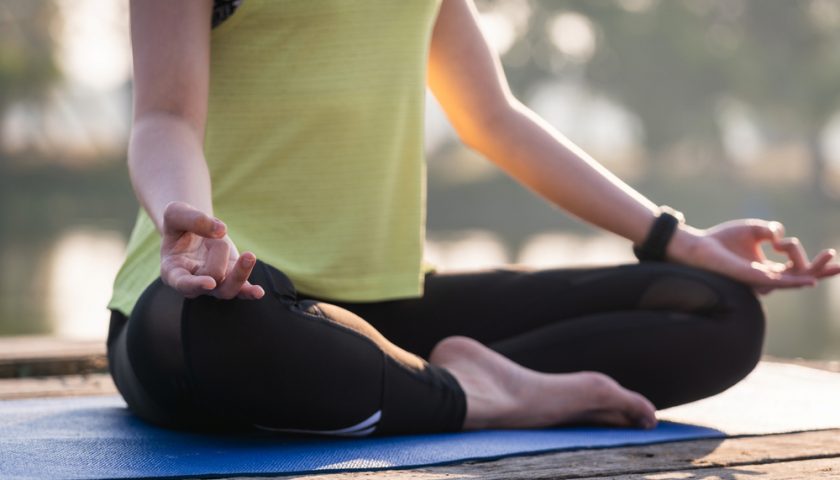Most people take their breathing for granted.
Except people with severe asthma.
Asthma causes the airways in your lungs to narrow, making it difficult to breathe.
Inhaled corticosteroids and beta-agonists open up your airways, making it easier to breathe.
These medications, however, may not be enough to control symptoms in some patients with severe asthma.
If you are wondering ‘how to breathe better with asthma’ and looking for a way to enhance your pharmacological treatment, breathing exercises are a good option.
Doctors didn’t recommend breathing exercises for asthma until recently since there wasn’t enough evidence to support their effectiveness. Recent research suggests that these breathing exercises may help you improve your breathing and overall quality of life.
Let’s get to know what these breathing exercises for asthma are to help you with your breathing quality.
Table of Contents
What is Asthma?
Here’s how it works:
Asthma is a chronic lung illness in which the airways carrying air from the nose and mouth to the lungs enlarge and narrow, making breathing more difficult.
Coughing, chest tightness, wheezing, and shortness of breath are the most typical asthma symptoms says, Dr Noor ul Arfeen – a top pulmonologist practicing in Lahore and Gujranwwala.
How Asthma Blocks Breathing?
Because asthma patients’ airways are limited, their lungs can’t fully empty, causing a buildup of air and a feeling of shortness of breath. Doctors often prescribe the medication to reduce the asthma symptoms, such as Acefyl syrup which is beneficial to control cough.
Breathing techniques seek to train the body to give more time for air to exit the lungs by inhaling deeply and exhaling slowly.
Why Breathing Exercises are Important for Asthma Patients?
Breathing exercises can benefit your lungs by improving your breathing and overall quality of life.
For asthmatics, there are a variety of breathing strategies that can be beneficial.
Some of the exercises aid with breathing retraining, while others strengthen the strength of respiratory muscles and improve rib cage flexibility.
A doctor or asthma clinic will frequently offer breathing strategies for asthma patients. Before trying the breathing exercises at home on your own, make sure you get them demonstrated by a professional.
Breathing Exercises for Asthma
Here are some of the trusted techniques and breathing exercises for asthma that you may find helpful:
Diaphragmatic Breathing
The diaphragm, a dome-shaped muscular barrier that separates the abdomen from the thorax and aids breathing, is strengthened by the diaphragmatic breathing technique.
The straightforward approach maximizes air diffusion in your lungs. You can also do this exercise, while sitting straight in a chair.
How to Practice Diaphragmatic Breathing?
- With your knees slightly bent, rest on your back. Underneath your knees, place a pillow.
- As you inhale deeply through your nose, place one hand flat on your chest and the other on your abdomen.
- Make sure your stomach goes out when you breathe in, but your chest stays stationary.
- Slowly exhale through pursed lips now.
- Practice until you can inhale and exhale without moving your chest.
Nasal Breathing
Breathing through the nose is referred to as nasal breathing.
This is a fantastic breathing exercise for asthma patients, unlike mouth breathing, which relates to severe asthma symptoms.
It adds humidity and warmth to the air, which can help to alleviate the symptoms.
How to Practice Nasal Breathing?
- Sit with your legs crossed in a comfortable position.
- Grasp the right knee with your right hand.
- Raise your left hand to your nose and bring it closer.
- Exhale completely, then close the left nostril with your left thumb and other fingers.
- Inhale deeply via your right nostril, then close it with your thumb and fingers.
- Breathe out from the left nostril.
- Before closing your left nostril, take a deep breath through it.
- Breathe out from the right nostril.
- For about five minutes, repeat this cycle.
- Remember to end with a right-side exhale to complete the cycle.
Papworth Method
The method teaches you how to breathe consistently and gently from the diaphragm and through the nostrils.
It also teaches you how to control stress so that your breathing is unaffected.
This strategy helps asthma sufferers enhance their quality of life and reduce their respiratory difficulties.
It is, nevertheless, thought to be useful in the treatment of moderate asthma induced by mouth breathing and fast breathing.
Patients with more severe asthma, which is often triggered by allergies and colds, may not find it helpful.
How to practice the Papworth Method?
- Inhale slowly through your nose.
- As if you were blowing out a candle, exhale through pursed lips. It’s important to remember that the exhale should be twice as lengthy as the inhalation.
- Repeat this process 3-5 times more.
Buteyko Breathing
Asthmatics have a tendency to hyperventilate, which means they breathe quicker and deeper than others.
Because rapid breathing can exacerbate asthma symptoms, buteyko breathing is frequently recommended.
You can actually learn to slow down your breathing rate using this technique.
How to Practice Buteyko Breathing?
- Take a seat in a comfy chair and sit up straight.
- As you take a deep breath, relax your abdomen and chest muscles. While doing so, keep your face straight and your eyes closed.
- Inhale via your nose while closing your mouth.
- Take a deep and shallow inhale at the same time.
- Now slowly exhale until you no longer feel your lungs are full of air.
- Hold your breath for as long as you can before gently breathing again.
Pursed Lip Breathing
When you have an asthma episode, this breathing technique is really useful.
The approach may help you exhale more air, making breathing easier, because the condition causes air to become trapped in the lungs.
It is one of the most effective breathing exercises for asthmatics who are out of breath.
How to Perform Pursed Lip Breathing?
- Slowly inhale through your nose while closing your mouth.
- Breathe out through pursed lips on the count of five, as if you were ready to blow a whistle or a candle.
- You should take twice as long to exhale as you do to inhale.
Yoga
You’re probably aware of yoga’s numerous benefits, but do you know that it can help with asthma flare-ups?
Practicing yoga on a regular basis can help to relieve and avoid asthma flare-ups, as well as lower the requirement for an inhaler by 43 percent.

Some of the yoga poses that focus on deep breathing exercises for asthma patients are:
Half Spinal Twist in Sitting
This exercise opens your chest muscles and enhances oxygen supply to the lungs, reducing asthma attacks.
Bridge Pose
One of the finest breathing exercises for asthmatics is Bridge Pose.
It balances your body by boosting digestion, opening up your lungs and chest, and minimizing thyroid issues.
Cobra Pose
Also known as Bhujangasana, cobra pose is an additional useful workout for asthma sufferers.
The cobra stance enhances blood and oxygen circulation throughout the body. It also clears the passageway to your lungs and opens up the chest, relieving asthma symptoms.
Easy Pose
This focuses on stress management and breathing.
It relaxes the brain, widens the chest, and gives you a sense of serenity and tranquility, all of which may help you avoid situations that could provoke an asthma attack.
Progressive Relaxation Technique
The gradual relaxation approach relaxes all of your body’s muscles.
It is one of the asthma breathing exercises that is recommended.
You tense a muscle group while breathing and then relax it while exhaling in this technique.
How to Perform Progressive Muscle Relaxation?
- Close your eyes and lie down on your back.
- Concentrate on breathing via your nose. The diaphragmatic breathing technique should be used.
- Tense the muscles in your right foot, then relax and slowly release them.
- Repeat with your left foot.
- Before returning to the beginning position, stay in a calm position for another 10-15 seconds.
Read more about effective home remedies for asthma.
Practice Makes Perfect!
Even if you’re in good health, you should practice deep breathing exercises on a daily basis to educate your body to adjust swiftly in the event of respiratory trouble.
Practise for at least 10 minutes every day.
You’ll be able to relax and cope with asthma symptoms better the more you practise. Furthermore, if you practise these strategies on a daily basis, you’ll instinctively know how to breathe better during an asthma attack.
Putting it all Together!
These breathing exercises may answer your query ‘how to breathe better with asthma’. Before trying any of these breathing exercises for asthma, consult your doctor to check that they are safe for you. It is recommended that you contact an asthma specialist who can instruct you on proper technique and methods for performing these exercises properly and safely.
You can book an appointment via Healthwire.pk or call at (042) 32500989.
